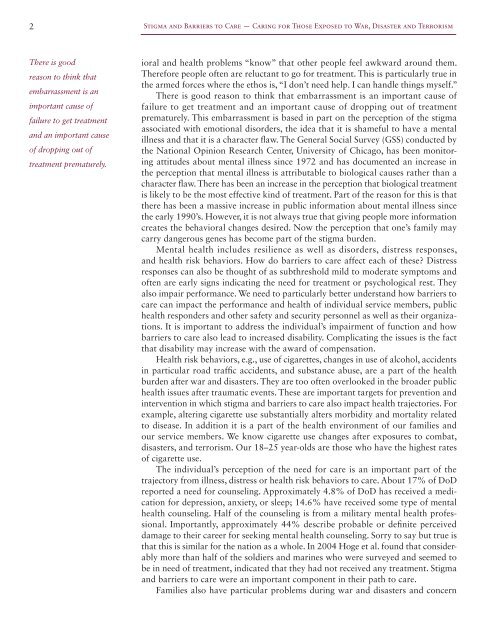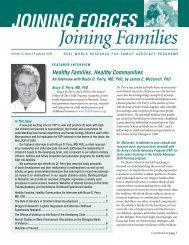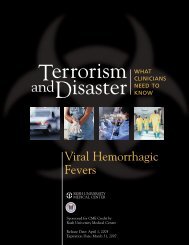stigma and barriers to care - Uniformed Services University of the ...
stigma and barriers to care - Uniformed Services University of the ...
stigma and barriers to care - Uniformed Services University of the ...
You also want an ePaper? Increase the reach of your titles
YUMPU automatically turns print PDFs into web optimized ePapers that Google loves.
2<br />
Stigma <strong>and</strong> Barriers <strong>to</strong> Care — Caring for Those Exposed <strong>to</strong> War, Disaster <strong>and</strong> Terrorism<br />
There is good<br />
reason <strong>to</strong> think that<br />
embarrassment is an<br />
important cause <strong>of</strong><br />
failure <strong>to</strong> get treatment<br />
<strong>and</strong> an important cause<br />
<strong>of</strong> dropping out <strong>of</strong><br />
treatment prematurely.<br />
ioral <strong>and</strong> health problems “know” that o<strong>the</strong>r people feel awkward around <strong>the</strong>m.<br />
Therefore people <strong>of</strong>ten are reluctant <strong>to</strong> go for treatment. This is particularly true in<br />
<strong>the</strong> armed forces where <strong>the</strong> ethos is, “I don’t need help. I can h<strong>and</strong>le things myself.”<br />
There is good reason <strong>to</strong> think that embarrassment is an important cause <strong>of</strong><br />
failure <strong>to</strong> get treatment <strong>and</strong> an important cause <strong>of</strong> dropping out <strong>of</strong> treatment<br />
prematurely. This embarrassment is based in part on <strong>the</strong> perception <strong>of</strong> <strong>the</strong> <strong>stigma</strong><br />
associated with emotional disorders, <strong>the</strong> idea that it is shameful <strong>to</strong> have a mental<br />
illness <strong>and</strong> that it is a character flaw. The General Social Survey (GSS) conducted by<br />
<strong>the</strong> National Opinion Research Center, <strong>University</strong> <strong>of</strong> Chicago, has been moni<strong>to</strong>ring<br />
attitudes about mental illness since 1972 <strong>and</strong> has documented an increase in<br />
<strong>the</strong> perception that mental illness is attributable <strong>to</strong> biological causes ra<strong>the</strong>r than a<br />
character flaw. There has been an increase in <strong>the</strong> perception that biological treatment<br />
is likely <strong>to</strong> be <strong>the</strong> most effective kind <strong>of</strong> treatment. Part <strong>of</strong> <strong>the</strong> reason for this is that<br />
<strong>the</strong>re has been a massive increase in public information about mental illness since<br />
<strong>the</strong> early 1990’s. However, it is not always true that giving people more information<br />
creates <strong>the</strong> behavioral changes desired. Now <strong>the</strong> perception that one’s family may<br />
carry dangerous genes has become part <strong>of</strong> <strong>the</strong> <strong>stigma</strong> burden.<br />
Mental health includes resilience as well as disorders, distress responses,<br />
<strong>and</strong> health risk behaviors. How do <strong>barriers</strong> <strong>to</strong> <strong>care</strong> affect each <strong>of</strong> <strong>the</strong>se Distress<br />
responses can also be thought <strong>of</strong> as subthreshold mild <strong>to</strong> moderate symp<strong>to</strong>ms <strong>and</strong><br />
<strong>of</strong>ten are early signs indicating <strong>the</strong> need for treatment or psychological rest. They<br />
also impair performance. We need <strong>to</strong> particularly better underst<strong>and</strong> how <strong>barriers</strong> <strong>to</strong><br />
<strong>care</strong> can impact <strong>the</strong> performance <strong>and</strong> health <strong>of</strong> individual service members, public<br />
health responders <strong>and</strong> o<strong>the</strong>r safety <strong>and</strong> security personnel as well as <strong>the</strong>ir organizations.<br />
It is important <strong>to</strong> address <strong>the</strong> individual’s impairment <strong>of</strong> function <strong>and</strong> how<br />
<strong>barriers</strong> <strong>to</strong> <strong>care</strong> also lead <strong>to</strong> increased disability. Complicating <strong>the</strong> issues is <strong>the</strong> fact<br />
that disability may increase with <strong>the</strong> award <strong>of</strong> compensation.<br />
Health risk behaviors, e.g., use <strong>of</strong> cigarettes, changes in use <strong>of</strong> alcohol, accidents<br />
in particular road traffic accidents, <strong>and</strong> substance abuse, are a part <strong>of</strong> <strong>the</strong> health<br />
burden after war <strong>and</strong> disasters. They are <strong>to</strong>o <strong>of</strong>ten overlooked in <strong>the</strong> broader public<br />
health issues after traumatic events. These are important targets for prevention <strong>and</strong><br />
intervention in which <strong>stigma</strong> <strong>and</strong> <strong>barriers</strong> <strong>to</strong> <strong>care</strong> also impact health trajec<strong>to</strong>ries. For<br />
example, altering cigarette use substantially alters morbidity <strong>and</strong> mortality related<br />
<strong>to</strong> disease. In addition it is a part <strong>of</strong> <strong>the</strong> health environment <strong>of</strong> our families <strong>and</strong><br />
our service members. We know cigarette use changes after exposures <strong>to</strong> combat,<br />
disasters, <strong>and</strong> terrorism. Our 18–25 year-olds are those who have <strong>the</strong> highest rates<br />
<strong>of</strong> cigarette use.<br />
The individual’s perception <strong>of</strong> <strong>the</strong> need for <strong>care</strong> is an important part <strong>of</strong> <strong>the</strong><br />
trajec<strong>to</strong>ry from illness, distress or health risk behaviors <strong>to</strong> <strong>care</strong>. About 17% <strong>of</strong> DoD<br />
reported a need for counseling. Approximately 4.8% <strong>of</strong> DoD has received a medication<br />
for depression, anxiety, or sleep; 14.6% have received some type <strong>of</strong> mental<br />
health counseling. Half <strong>of</strong> <strong>the</strong> counseling is from a military mental health pr<strong>of</strong>essional.<br />
Importantly, approximately 44% describe probable or definite perceived<br />
damage <strong>to</strong> <strong>the</strong>ir <strong>care</strong>er for seeking mental health counseling. Sorry <strong>to</strong> say but true is<br />
that this is similar for <strong>the</strong> nation as a whole. In 2004 Hoge et al. found that considerably<br />
more than half <strong>of</strong> <strong>the</strong> soldiers <strong>and</strong> marines who were surveyed <strong>and</strong> seemed <strong>to</strong><br />
be in need <strong>of</strong> treatment, indicated that <strong>the</strong>y had not received any treatment. Stigma<br />
<strong>and</strong> <strong>barriers</strong> <strong>to</strong> <strong>care</strong> were an important component in <strong>the</strong>ir path <strong>to</strong> <strong>care</strong>.<br />
Families also have particular problems during war <strong>and</strong> disasters <strong>and</strong> concern




